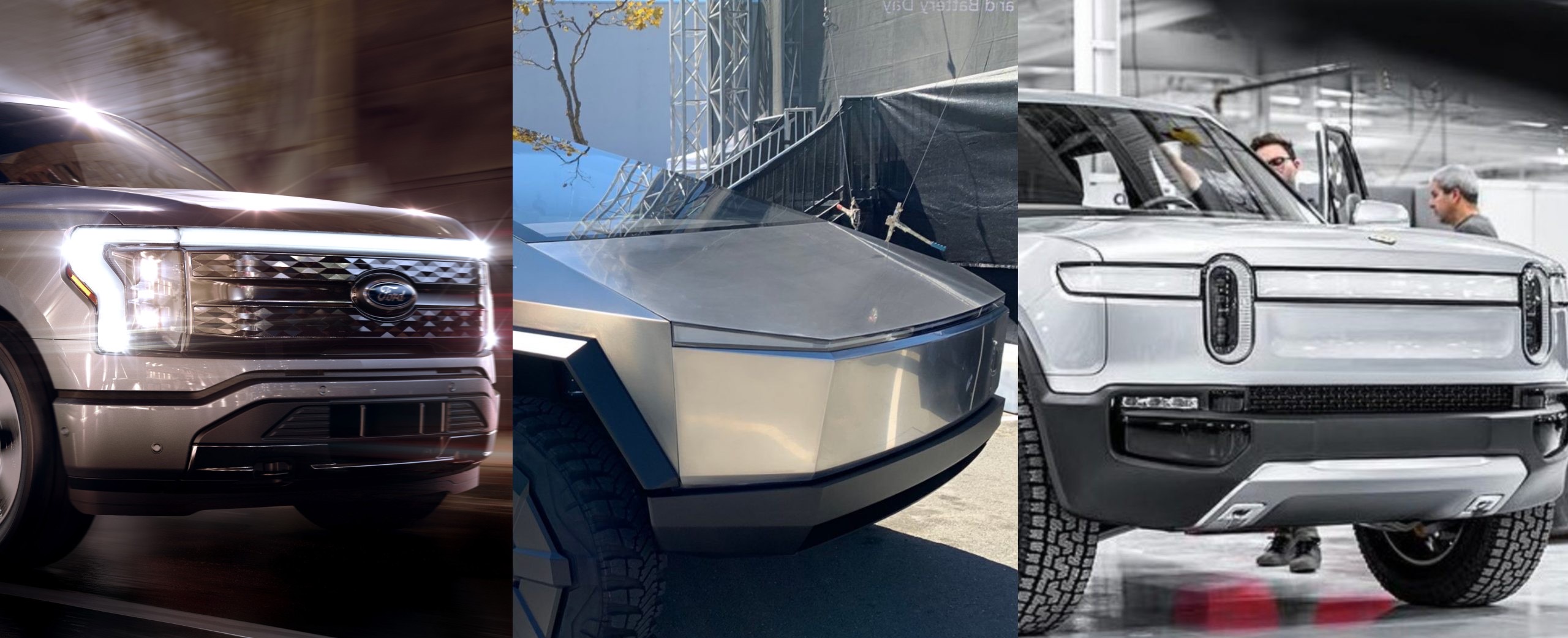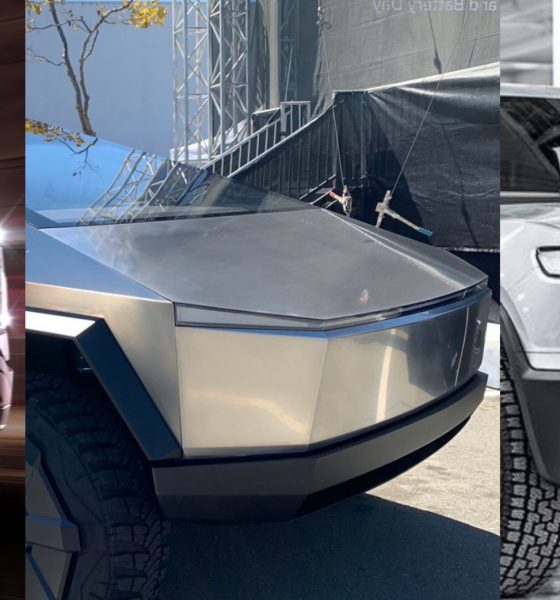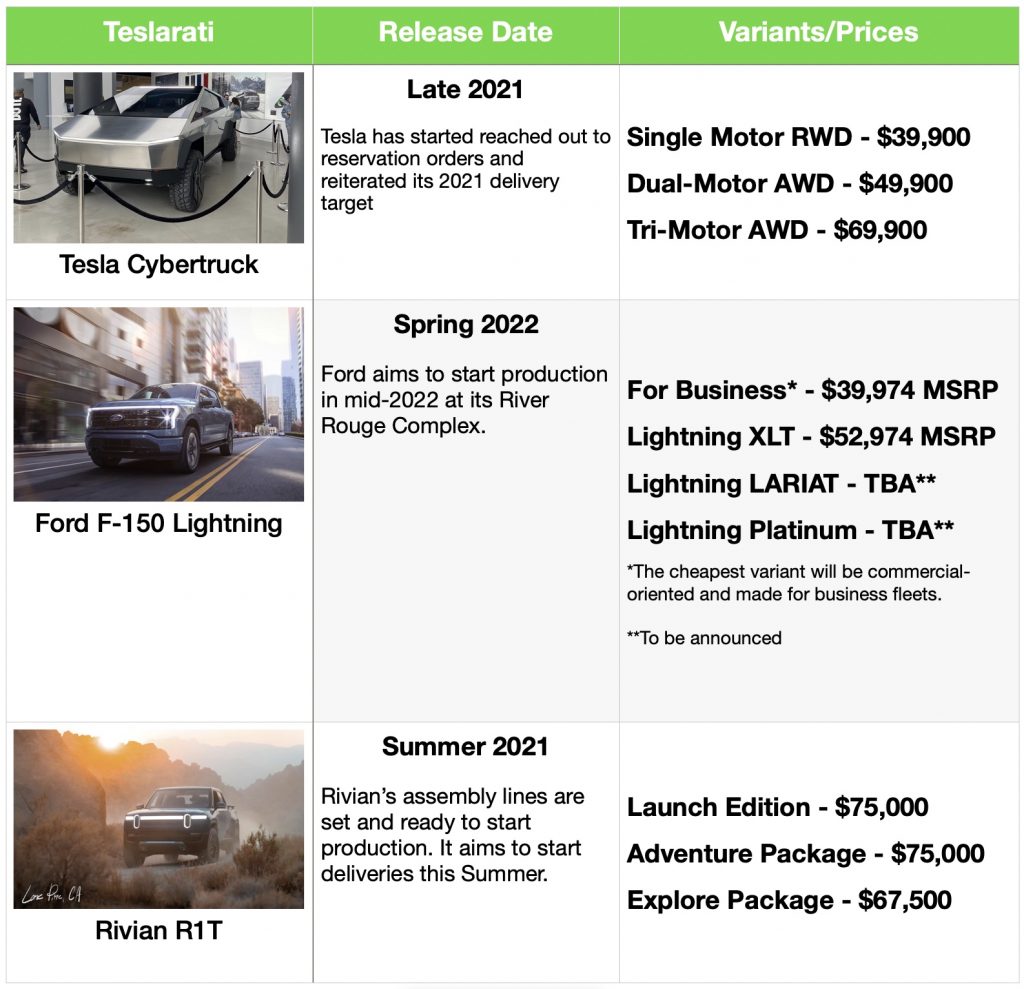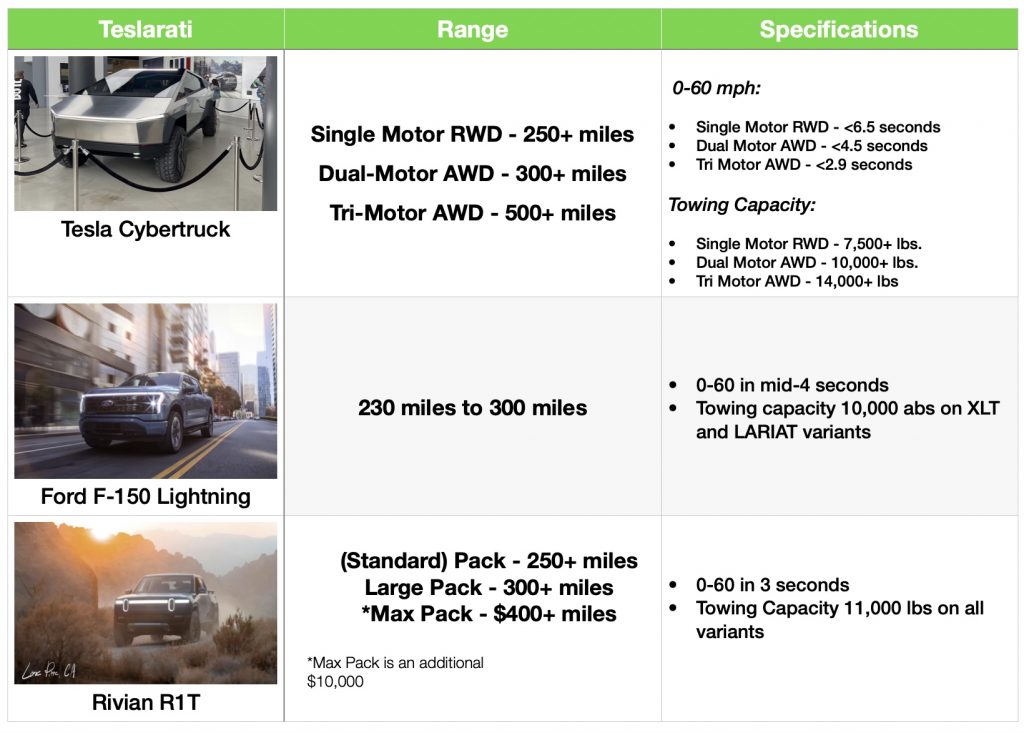

News
F-150 Lightning vs Tesla Cybertruck vs Rivian R1T: How Ford’s new EV stacks up against younger competitors
Ford recently unveiled the F-150 Lightning, marking the entry of another legacy automaker into the all-electric pickup truck market. The Ford F-150 is an iconic pickup truck, and its transition to the electric vehicle spectrum is a big step for American auto manufacturing.
However, as the Ford F-150 enters a new playing field, the OEM will be met with new contenders from startup EV makers such as Rivian and Tesla. While the Ford F-150 has been the standard for pickup trucks, Tesla has made a name for itself in the EV space. Rivian seeks to forge its own path in the EV market by delivering the first all-electric pickup truck to customers as well.

Rivian aims to start deliveries of the R1T Launch Edition in June 2021. As such, the Rivian R1T will be the first all-electric pickup truck to hit the market. Rivian told Teslarati that it has started contacting reservation holders in preparation for deliveries. Along with the start of deliveries, Rivian plans to launch a 4-month Demonstration Drive program across the United States to help new owners navigate their R1T pickup trucks.
The Tesla Cybertruck will be produced in Gigafactory Texas, which has been progressing rather quickly. Tesla has also started reaching out to Cybertruck reservation holders and reiterating its late 2021 delivery goal for the Tri-Motor AWD and Dual-Motor AWD variants.
Ford still has about a year to go before producing the all-electric F-150 Lightning at its Rouge plant. The legacy automaker plans to produce four variants of the F-150 Lightning, including one specifically produced and priced for business owners. Ford has not listed the price of the Lariat or Platinum yet. However, it did state that the Lightning’s MSRP starts at $39,974 and goes up to $90,474.

When it comes to function and utility, each of the electric pickup trucks has its advantages. For instance, Rivian made the R1T for owners who seek adventures outdoors. To accommodate future R1T explorers, Rivian has included certain features like the Gear Tunnel for muddy or wet items and an air compressor with a maximum pressure of 150 psi for tires or inflatable items.
On the other hand, the Ford F-150 Lightning seems geared more towards business owners. Ford seems to know its customer base very well as it added certain details to the F-150 Lightning that would be useful on the job site, like enhanced zone lighting and a slew of power outlets both front and back.
In a unique twist, the OEM also built the F-150 Lightning with Ford Intelligent backup power, allowing the vehicle to off-board up to 9.6 kW of peak energy. Ford estimates that the F-150 Lightning can power an entire home for three days or up to ten days if the power is rationed. Its estimates are based on home usage of 30 kWh per day using the F-150 Lightning’s extended battery.
The Tesla Cybertruck seems to tread the middle ground compared to the Rivian R1T and the Ford F-150 Lightning. Each Cybertruck variant could meet the need of explorers or business owners. Tesla also has its unique software system for Cybertruck owners, which has become an ecosystem of its own with features like Camp Mode, Dog Mode, Sentry Mode, and Tesla Theater, among others.
The Teslarati team would appreciate hearing from you. If you have any tips, email us at tips@teslarati.com or reach out to me at maria@teslarati.com.

Elon Musk
Starlink passes 9 million active customers just weeks after hitting 8 million
The milestone highlights the accelerating growth of Starlink, which has now been adding over 20,000 new users per day.

SpaceX’s Starlink satellite internet service has continued its rapid global expansion, surpassing 9 million active customers just weeks after crossing the 8 million mark.
The milestone highlights the accelerating growth of Starlink, which has now been adding over 20,000 new users per day.
9 million customers
In a post on X, SpaceX stated that Starlink now serves over 9 million active users across 155 countries, territories, and markets. The company reached 8 million customers in early November, meaning it added roughly 1 million subscribers in under seven weeks, or about 21,275 new users on average per day.
“Starlink is connecting more than 9M active customers with high-speed internet across 155 countries, territories, and many other markets,” Starlink wrote in a post on its official X account. SpaceX President Gwynne Shotwell also celebrated the milestone on X. “A huge thank you to all of our customers and congrats to the Starlink team for such an incredible product,” she wrote.
That growth rate reflects both rising demand for broadband in underserved regions and Starlink’s expanding satellite constellation, which now includes more than 9,000 low-Earth-orbit satellites designed to deliver high-speed, low-latency internet worldwide.
Starlink’s momentum
Starlink’s momentum has been building up. SpaceX reported 4.6 million Starlink customers in December 2024, followed by 7 million by August 2025, and 8 million customers in November. Independent data also suggests Starlink usage is rising sharply, with Cloudflare reporting that global web traffic from Starlink users more than doubled in 2025, as noted in an Insider report.
Starlink’s momentum is increasingly tied to SpaceX’s broader financial outlook. Elon Musk has said the satellite network is “by far” the company’s largest revenue driver, and reports suggest SpaceX may be positioning itself for an initial public offering as soon as next year, with valuations estimated as high as $1.5 trillion. Musk has also suggested in the past that Starlink could have its own IPO in the future.
News
NVIDIA Director of Robotics: Tesla FSD v14 is the first AI to pass the “Physical Turing Test”
After testing FSD v14, Fan stated that his experience with FSD felt magical at first, but it soon started to feel like a routine.

NVIDIA Director of Robotics Jim Fan has praised Tesla’s Full Self-Driving (Supervised) v14 as the first AI to pass what he described as a “Physical Turing Test.”
After testing FSD v14, Fan stated that his experience with FSD felt magical at first, but it soon started to feel like a routine. And just like smartphones today, removing it now would “actively hurt.”
Jim Fan’s hands-on FSD v14 impressions
Fan, a leading researcher in embodied AI who is currently solving Physical AI at NVIDIA and spearheading the company’s Project GR00T initiative, noted that he actually was late to the Tesla game. He was, however, one of the first to try out FSD v14.
“I was very late to own a Tesla but among the earliest to try out FSD v14. It’s perhaps the first time I experience an AI that passes the Physical Turing Test: after a long day at work, you press a button, lay back, and couldn’t tell if a neural net or a human drove you home,” Fan wrote in a post on X.
Fan added: “Despite knowing exactly how robot learning works, I still find it magical watching the steering wheel turn by itself. First it feels surreal, next it becomes routine. Then, like the smartphone, taking it away actively hurts. This is how humanity gets rewired and glued to god-like technologies.”
The Physical Turing Test
The original Turing Test was conceived by Alan Turing in 1950, and it was aimed at determining if a machine could exhibit behavior that is equivalent to or indistinguishable from a human. By focusing on text-based conversations, the original Turing Test set a high bar for natural language processing and machine learning.
This test has been passed by today’s large language models. However, the capability to converse in a humanlike manner is a completely different challenge from performing real-world problem-solving or physical interactions. Thus, Fan introduced the Physical Turing Test, which challenges AI systems to demonstrate intelligence through physical actions.
Based on Fan’s comments, Tesla has demonstrated these intelligent physical actions with FSD v14. Elon Musk agreed with the NVIDIA executive, stating in a post on X that with FSD v14, “you can sense the sentience maturing.” Musk also praised Tesla AI, calling it the best “real-world AI” today.
News
Tesla AI team burns the Christmas midnight oil by releasing FSD v14.2.2.1
The update was released just a day after FSD v14.2.2 started rolling out to customers.

Tesla is burning the midnight oil this Christmas, with the Tesla AI team quietly rolling out Full Self-Driving (Supervised) v14.2.2.1 just a day after FSD v14.2.2 started rolling out to customers.
Tesla owner shares insights on FSD v14.2.2.1
Longtime Tesla owner and FSD tester @BLKMDL3 shared some insights following several drives with FSD v14.2.2.1 in rainy Los Angeles conditions with standing water and faded lane lines. He reported zero steering hesitation or stutter, confident lane changes, and maneuvers executed with precision that evoked the performance of Tesla’s driverless Robotaxis in Austin.
Parking performance impressed, with most spots nailed perfectly, including tight, sharp turns, in single attempts without shaky steering. One minor offset happened only due to another vehicle that was parked over the line, which FSD accommodated by a few extra inches. In rain that typically erases road markings, FSD visualized lanes and turn lines better than humans, positioning itself flawlessly when entering new streets as well.
“Took it up a dark, wet, and twisty canyon road up and down the hill tonight and it went very well as to be expected. Stayed centered in the lane, kept speed well and gives a confidence inspiring steering feel where it handles these curvy roads better than the majority of human drivers,” the Tesla owner wrote in a post on X.
Tesla’s FSD v14.2.2 update
Just a day before FSD v14.2.2.1’s release, Tesla rolled out FSD v14.2.2, which was focused on smoother real-world performance, better obstacle awareness, and precise end-of-trip routing. According to the update’s release notes, FSD v14.2.2 upgrades the vision encoder neural network with higher resolution features, enhancing detection of emergency vehicles, road obstacles, and human gestures.
New Arrival Options also allowed users to select preferred drop-off styles, such as Parking Lot, Street, Driveway, Parking Garage, or Curbside, with the navigation pin automatically adjusting to the ideal spot. Other refinements include pulling over for emergency vehicles, real-time vision-based detours for blocked roads, improved gate and debris handling, and Speed Profiles for customized driving styles.








